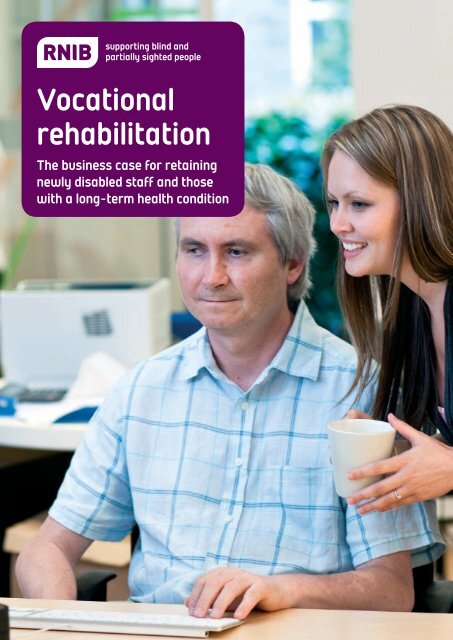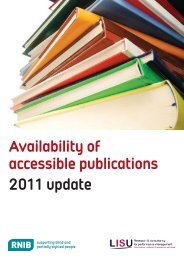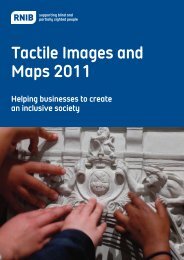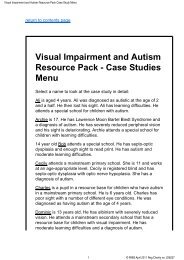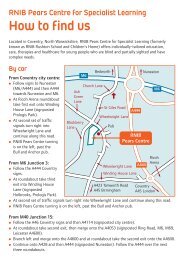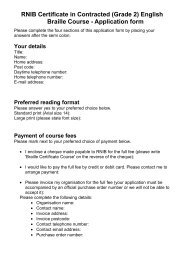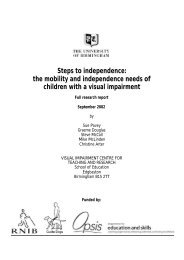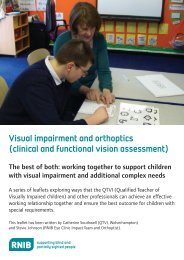Vocational rehabilitation: The business case for retaining ... - RNIB
Vocational rehabilitation: The business case for retaining ... - RNIB
Vocational rehabilitation: The business case for retaining ... - RNIB
Create successful ePaper yourself
Turn your PDF publications into a flip-book with our unique Google optimized e-Paper software.
<strong>Vocational</strong><br />
<strong>rehabilitation</strong><br />
<strong>The</strong> <strong>business</strong> <strong>case</strong> <strong>for</strong> <strong>retaining</strong><br />
newly disabled staff and those<br />
with a long-term health condition
Preface<br />
I’m pleased to write this introduction to an important report on vocational <strong>rehabilitation</strong><br />
in the workplace by Philip Connolly of <strong>RNIB</strong>.<br />
ACAS firmly supports measures to retain employees who acquire health issues or long<br />
term impairments; there are strong <strong>business</strong> reasons <strong>for</strong> doing so and this report makes<br />
the <strong>case</strong> convincingly and clearly by setting out the costs balanced by the potential<br />
savings that can be realised by a policy of vocational <strong>rehabilitation</strong>.<br />
This hard evidence should persuade all Boards of the importance and organisational<br />
benefits of vocational <strong>rehabilitation</strong>. This is a policy that will have a growing impact on<br />
your company. Our aging work<strong>for</strong>ce, the removal of mandatory retirement and a clear<br />
correlation between wellbeing at work and <strong>business</strong> success are just three reasons why<br />
your work<strong>for</strong>ce would benefit from such an approach in the future.<br />
However, I’m clear in my mind that <strong>for</strong> these benefits to be realised there must be<br />
buy-in at all levels within organisations, especially by senior management who set the<br />
strategic direction <strong>for</strong> <strong>rehabilitation</strong> and equally by first line managers – as these are the<br />
very colleagues who will deal directly with employees who may be newly disabled.<br />
<strong>The</strong> importance of getting that first contact right is crucial not<br />
only to the person concerned but to his or her colleagues to ensure<br />
the workplace remains constructive, productive and free from<br />
prejudice. To support this report, we have produced a podcast that<br />
gives tips on how to manage these important conversations. Visit<br />
www.acas.org.uk<br />
John Taylor, CCMI<br />
Chief Executive, ACAS<br />
It is in employers interests to make sure they make their best ef<strong>for</strong>ts to recruit and<br />
retain talent from the widest possible pools. Even in today’s tough economic climate,<br />
the evidence shows that getting people with the right skills, ability<br />
and potential is a serious challenge. Increasingly, organisations<br />
are adopting smarter recruitment and retention policies that stop<br />
hidden barriers and unfair employment practices getting in the<br />
way. <strong>The</strong>y do so because it makes <strong>business</strong> sense to do so. <strong>The</strong><br />
guide suggests why and how employers can move <strong>for</strong>ward.<br />
Dianah Worman OBE Chartered FCIPD<br />
CIPD Public Policy Adviser Diversity<br />
2
Contents<br />
Introduction 4<br />
<strong>The</strong> <strong>case</strong> <strong>for</strong> employment retention 5<br />
Evidence that vocational <strong>rehabilitation</strong> is cost-effective 8<br />
How to identify the costs and savings 13<br />
Why everyone benefits 19<br />
Recommendations 21<br />
References 22<br />
Acknowledgements 23<br />
Appendix 1: Additional sources of in<strong>for</strong>mation 24<br />
Appendix 2: Model conversation <strong>for</strong> line managers 29<br />
Appendix 3: <strong>The</strong> role of technology in supporting people to retain employment 31<br />
Appendix 4: <strong>The</strong> Employment Retention Charter 33<br />
3
Introduction<br />
Dame Carol Black’s review “Working <strong>for</strong> a healthier tomorrow” (2008) confirms the<br />
benefits to the UK economy from managing the health of the working-age population.<br />
<strong>The</strong> review highlighted that the average UK employee is absent from work due to<br />
sickness <strong>for</strong> 6 days per year. <strong>The</strong> figure varies from one workplace to another but it adds<br />
up to an estimated annual cost of £598 per employer. <strong>The</strong> estimated cost to the UK<br />
economy is £10 billion annually.<br />
Estimates vary of the numbers of people<br />
relinquishing their employment status as a result<br />
of the onset of disability or long-term sickness.<br />
One study (Meager et al, 1998) estimated that<br />
every year about three per cent of the working<br />
age population become impaired and within a<br />
year one in six of these people will lose their jobs – about 35,000 people. <strong>The</strong> National<br />
Institute <strong>for</strong> Health and Clinical Excellence (NICE) and the Chartered Institute of<br />
Personnel and Development (CIPD) collectively suggest that around one in a hundred<br />
people are off work at any one time through long-term sickness and around a sixth of<br />
these people have an impairment – around 48,000 people. In all likelihood this group of<br />
people will go on to claim out-of-work benefits.<br />
This report seeks to empower both the employer and the employee. Whereas previous<br />
work has looked at the benefits <strong>for</strong> the UK economy or an individual <strong>business</strong>, this<br />
report aims to additionally establish the <strong>business</strong> <strong>case</strong> <strong>for</strong> <strong>retaining</strong> a single employee.<br />
<strong>The</strong> <strong>RNIB</strong> group of charities provides a retention<br />
service that helps some 750 blind and partially<br />
sighted people each year to stay in work, but<br />
this is likely to be only a handful of those that<br />
need that support. Research <strong>for</strong> the Government<br />
report “Ready <strong>for</strong> Work” (DWP, 2007) found that<br />
6 days per year<br />
Average sickness absence<br />
of UK workers<br />
£10 billion a year<br />
Cost of sickness absence<br />
to UK economy<br />
a third of the survey’s respondents had left employment because of their disability or<br />
impairment. Some 92 per cent of these people felt that they could have stayed in their<br />
job had interventions been made but they were not offered any adaptations, aids or<br />
adjustments.<br />
4
<strong>The</strong> <strong>case</strong> <strong>for</strong> employment retention<br />
<strong>The</strong> Government’s welfare to work policies are<br />
based upon the central premise that work is<br />
good <strong>for</strong> health. This premise is based upon a<br />
literature review of some four hundred studies<br />
in “<strong>Vocational</strong> Rehabilitation: What Works,<br />
For Whom and When” by Waddell, Burton<br />
and Kendall, 2008. That same report found: ”<strong>Vocational</strong> <strong>rehabilitation</strong> needs to be<br />
underpinned by education to in<strong>for</strong>m the public, health professionals and employers<br />
about the value of work <strong>for</strong> health and recovery, and their part in the return to work<br />
process.”<br />
<strong>Vocational</strong> <strong>rehabilitation</strong><br />
“Work is good <strong>for</strong><br />
health”<br />
<strong>Vocational</strong> <strong>rehabilitation</strong> is whatever helps someone with a health problem to stay at or<br />
return to and remain in work. It is an idea or an approach as much as an intervention.<br />
But any idea requires translation if it is to become practical.<br />
5
Employment retention<br />
Employment retention is the process whereby a newly disabled employee or one with a<br />
long-term health condition benefits from an assessment to determine their capacity to<br />
work and interventions in or out of the workplace that may be needed to enable them<br />
to adapt to their impairment or health condition within the work context.<br />
During this period of <strong>rehabilitation</strong>, they would agree a plan, setting out in-work or<br />
out-of-workplace support, enabling them to adjust to their new life circumstances and<br />
acquire any disability skills that would enable them to return to work. <strong>The</strong> plan would<br />
be to return to either their old job or one where some tasks have been given to other<br />
people and new ones to them.<br />
<strong>The</strong> policy is distinct from sick leave in that it is aimed at contracted employees who,<br />
with the right interventions and support, are capable of work but who require further<br />
assessment, treatment and/or <strong>rehabilitation</strong>. <strong>The</strong> assessment is key and should ideally<br />
be carried out within two to four weeks of the person becoming disabled or a health<br />
condition likely to have a long-term impact. Any period of <strong>rehabilitation</strong> agreed would<br />
be subject to a test of reasonableness; account would be taken of the employee’s<br />
duties, the resources available to the employer and the employee’s prognosis.<br />
<strong>The</strong> elements of an effective employment retention policy are:<br />
senior management engagement<br />
joint labour-management cooperation<br />
line managers playing a key role<br />
monitoring and in<strong>for</strong>mation systems<br />
early regular and sensitive contact with workers<br />
<strong>for</strong>mal return to work plans and processes<br />
fast tracking healthcare (if required)<br />
provision of modified arrangement or adjustments (if required)<br />
use of <strong>case</strong> management (if required)<br />
• use of structured vocational <strong>rehabilitation</strong> programmes (<strong>for</strong> small minority of workers<br />
who need them)<br />
• treating the employee the same regardless of whether the injury or sickness began<br />
at work or elsewhere.<br />
Resources to support employers<br />
Resources are available to support employers in establishing best practice. A guide<br />
from the Health and Safety Executive on “Managing Sickness Absence” and a ready<br />
6
eckoner guide to assess when to intervene can be downloaded at www.hse.gov.uk.<br />
ACAS has produced a guide on “Managing Attendance and Employee Turnover” and<br />
this can be obtained at www.acas.org.uk. NICE has produced guidance on managing<br />
long-term sickness and incapacity <strong>for</strong> work and this can be downloaded at www.nice.<br />
org.uk/PH19/. On page 22 of the guidance a flow chart can be found that sets out<br />
the pathway <strong>for</strong> managing the process. In addition, an excellent series of guides <strong>for</strong><br />
line managers working with disabled colleagues can be purchased from the Employers<br />
Forum on Disabilities.<br />
Dealing with retention in the absence of a policy or<br />
HR specialist<br />
Many small organisations have no HR specialist<br />
nor have they had any previous experience<br />
of dealing with a newly disabled employee<br />
or one with a long-term health condition.<br />
Understandably many managers are worried<br />
about being unintentionally discriminatory or the<br />
relationship with the employee breaking down<br />
and even the possibility of a tribunal. However,<br />
good communication between the manager<br />
“Good<br />
communication<br />
between<br />
managers and<br />
workers is key”<br />
and employee can help manage even the most challenging situations effectively. In<br />
Appendix 2 of this report is a model conversation between Susan, a manager of a small<br />
office cleaning company that employs seven people, and Adam, the leading salesman<br />
who has just been diagnosed with Crohns disease.<br />
ACAS have similar model conversations to this one on their own website as<br />
podcasts and these can be downloaded at Equality http://www.acas.org.uk/<br />
index.aspx?articleid=1363 and at Disability http://www.acas.org.uk/<br />
index.aspx?articleid=1859<br />
7
Evidence that vocational<br />
<strong>rehabilitation</strong> is cost-effective<br />
<strong>The</strong> report “<strong>Vocational</strong> Rehabilitation: What<br />
Works, For Whom and When” (Waddell et al,<br />
2008) found: “<strong>The</strong>re is strong evidence and<br />
considerable UK <strong>business</strong> experience that<br />
sickness absence and disability management is<br />
cost effective and may reduce sickness absence<br />
between 20 per cent and 60 per cent.”<br />
“Sickness<br />
absence could be<br />
reduced by up to<br />
60 per cent”<br />
<strong>The</strong> literature on vocational <strong>rehabilitation</strong> includes several references to the cost<br />
benefits of the policy (Marsden et al, 2004). One example is provided by a study<br />
(Hunter et al, 2006) of 89 people with lower back pain (working <strong>for</strong> a water utility<br />
company). Each was given a functional restorative programme (FRP), including aerobic<br />
exercise, graded flexibility and strength training, work conditioning, education and job<br />
specific training to facilitate self-management and safe working practices. <strong>The</strong> mean<br />
cost per employee <strong>for</strong> sickness absence in the twenty-four months pre-programme was<br />
£1,988. In the 24 months post programme this reduced to £618. Amongst the findings<br />
the study reported: “<strong>The</strong> average cost of the functional restoration programme (FRP)<br />
<strong>for</strong> each participant was £917 per person. Assuming sickness absence would have<br />
continued or increased over time without active intervention, there appears to be a cost<br />
saving to the company.”<br />
<strong>The</strong>re is also official guidance in support of our <strong>business</strong> <strong>case</strong>. In 2009 NICE produced a<br />
“Costing Report” <strong>for</strong> implementing their guidance. <strong>The</strong>y concluded that, where the cost<br />
attributable to each sick day was greater than £63.36, it was reasonable to assume that<br />
implementing the guidance would save money (section 3.1.18).<br />
8
Case studies<br />
College of Occupational<br />
<strong>The</strong>rapists<br />
Further indication of the relatively<br />
low cost of interventions to achieve<br />
employment retention has been<br />
obtained through two <strong>case</strong> studies<br />
from the College of Occupational<br />
<strong>The</strong>rapists. In the first, an office<br />
worker (on a salary of £25,000)<br />
with rheumatoid arthritis, suffering<br />
from pains and limited movement<br />
in the finger and hand joints, was<br />
able to remain in work following a<br />
mere £101.94 spent on professional<br />
occupational therapist time and<br />
treatment. In the second <strong>case</strong>, a<br />
person making cardboard boxes<br />
on a salary of £15,000 incurred<br />
osteoarthritis in her carpometacarpal<br />
joint of her thumb on her left hand<br />
and carpal tunnel syndrome in her<br />
right hand. She was able to resume<br />
her duties following £145.87 being<br />
spent on professional therapist time<br />
and splints. In both instances the<br />
employee was supported to remove<br />
their need <strong>for</strong> going off sick and<br />
requiring sickness pay.<br />
On occasion more intensive<br />
interventions are required and <strong>case</strong><br />
studies bear out the value <strong>for</strong> money<br />
or <strong>business</strong> <strong>case</strong> from investing in<br />
vocational <strong>rehabilitation</strong>.<br />
“Rolls Royce saved<br />
£11 million by reducing<br />
sickness absence”<br />
Port of London Authority<br />
One example of a UK <strong>business</strong><br />
benefiting from the introduction<br />
of a sickness absence management<br />
programme is that of the Port of<br />
London Authority (PLA). <strong>The</strong> PLA<br />
improved their occupational health<br />
services and trained their line<br />
managers on the causes of absence<br />
and return to work plans. <strong>The</strong><br />
<strong>business</strong> benefits included a 70 per<br />
cent drop in staff sickness absence<br />
with a comparable reduction in longterm<br />
absence too. <strong>The</strong> gain was the<br />
equivalent of having an extra 30<br />
people at work at any one time.<br />
Rolls Royce<br />
Rolls Royce implemented a sickness<br />
absence management system and<br />
early intervention of <strong>rehabilitation</strong>.<br />
Anyone off work <strong>for</strong> more than four<br />
weeks was provided with a return-towork<br />
action plan by their line manager<br />
and occupational health support.<br />
This support included early access to<br />
in house physiotherapy. Rolls Royce<br />
invested in an IT monitoring system,<br />
staff and line managers training and<br />
some staff time in consulting on the<br />
<strong>for</strong>mation of the policy. At the time of<br />
monitoring the benefits of the policy<br />
Rolls Royce were able to identify a<br />
reduction of 28,500 work days in<br />
sickness absence from a baseline of<br />
191,000. This reduction represented<br />
a saving or some £11 million.<br />
9
British Polythene Industries<br />
British Polythene Industries Plc<br />
documented the cost benefit ratio<br />
from investing in a “Musculoskeletal<br />
Injury Management System” (MIMS)<br />
provided by Osteopaths <strong>for</strong> Industry.<br />
MIMS was a service that treated<br />
injuries within 24 to 48 hours,<br />
oversaw each absence and provided<br />
a company-wide view on injuries.<br />
<strong>The</strong> service started with an initial<br />
assessment and each referral typically<br />
received three treatments. Three<br />
quarters of employees returned to<br />
work whilst undergoing treatment.<br />
For the year <strong>for</strong> which the monitoring<br />
was conducted, the company spent<br />
£16,000 on the service and estimated<br />
the annual saving on staff absence as<br />
being £192,000. A cost benefit ratio<br />
of 12:1.<br />
West Suffolk Hospital<br />
NHS Trust<br />
<strong>The</strong> Boorman review of the NHS<br />
documented the <strong>case</strong> of West<br />
Suffolk Hospital NHS Trust. <strong>The</strong><br />
trust introduced a system of<br />
priority treatment referrals to a<br />
local physiotherapist <strong>for</strong> injured<br />
staff. In the first nine months of<br />
operating the system, 104 staff were<br />
referred, the number of days lost to<br />
sickness absence was reduced by<br />
40 per cent and the direct costs of<br />
musculoskeletal injuries to the Trust<br />
were reduced by more than £170,000.<br />
This was done at a cost of £21,000.<br />
Royal Mail<br />
Royal Mail introduced a strategy to<br />
address musculo-skeletal diseases,<br />
the largest cause of sickness absence.<br />
<strong>The</strong>ir strategy was based upon a<br />
<strong>rehabilitation</strong> psycho-social model.<br />
<strong>The</strong> intervention resulted in 70 per<br />
cent of people coming back to their<br />
normal duties (sometimes part-time).<br />
Royal Mail also reported a return on<br />
their investment of £2.50 <strong>for</strong> every £1<br />
invested.<br />
10
How the benefits outweigh the costs<br />
Some <strong>business</strong>es have insured against the costs<br />
of the intervention measures and any period<br />
away from work that may be required. A study<br />
produced by the Association of British Insurers<br />
(Wright et al, 2004) pointed out that the ratio<br />
of benefits to costs were greater <strong>for</strong> employers<br />
than insurers due to the gains in workplace<br />
productivity. <strong>The</strong>ir report concluded: “So taking<br />
the mid points in the ranges <strong>for</strong> liability claims<br />
costs savings (insurers) and employers costs, the benefits ratio between claims costs<br />
savings (insurers) and employers uninsured costs would be around 1:9. In other words<br />
the likely reduction in employers uninsured costs are likely to significantly outweigh any<br />
reduction in costs to employer’s liability.”<br />
Published <strong>case</strong> studies such as those cited above have demonstrated the value of<br />
occupational health and early intervention.<br />
Direct benefits arise from:<br />
reduced insurance premiums<br />
reduced litigation costs<br />
reduced sick pay costs<br />
improved productivity<br />
lower accident costs/production delays<br />
• reduced product and material damage.<br />
Indirect benefits arise from:<br />
reduced absenteeism<br />
reduced staff turnover<br />
improved corporate image<br />
improved chance of winning contracts<br />
• improved job satisfaction/morale.<br />
£160,000 per<br />
worker<br />
Cost to the Post Office of<br />
early retirement on health<br />
grounds<br />
All of these benefits have a financial implication. <strong>The</strong> loss of trained and experienced<br />
staff prematurely moving onto benefits and pensions is expensive. <strong>The</strong> UK Post Office<br />
has estimated that each early retirement on health grounds costs in the region of<br />
£160,000 (CSR Europe, 2007).<br />
11
Studies of <strong>rehabilitation</strong> programmes in Australia provide cost benefit analysis<br />
calculations (Kenyon, 2003). <strong>The</strong> study analysed 16,348 clients who received<br />
vocational <strong>rehabilitation</strong> over an 18 month period to December 2002. <strong>The</strong> average<br />
client had approximately 30 hours contact with CRS Australia (the leading provider<br />
of disability employment services and part of the Australian Government’s<br />
Department of Human Resources). Of which 4.5 hours were spent in pre-programme<br />
activities including referral and initial assessment. <strong>The</strong> total Social Benefit per client<br />
associated with participation in a CRS Australia programme is $133,389 (£86,867).<br />
Since the average cost per CRS Australia client is equal to $4,398 (£2,864), which<br />
includes costs from assessment, referral and external costs as well as the programme<br />
costs, the Net Social Benefit is $128,991 (£84,021), with a benefit to cost ratio of<br />
30.33 to 1.<br />
Is there anyone whose condition puts them beyond cost<br />
effective reach or help?<br />
At present there is no ready answer to this<br />
question but what is apparent is that people<br />
whose conditions previously meant that they<br />
were considered difficult to retain in work<br />
are in fact receptive to help (Burton et al,<br />
2008). <strong>The</strong>re is strong evidence, (mainly <strong>for</strong><br />
musculoskeletal conditions) that workplace<br />
based health interventions are cost effective.<br />
Good quality research also demonstrates that<br />
disease management programmes <strong>for</strong> people<br />
with depression are also cost effective and result<br />
in employees being significantly more likely to<br />
hold down their jobs.<br />
“Costs are within<br />
the scope of other<br />
widely accepted<br />
public health<br />
improvements.”<br />
Neumeyer-Gronen et al,<br />
2002, p2011<br />
12
How to identify the costs and<br />
savings<br />
Costs of sickness absence<br />
<strong>The</strong> costs to employers will naturally vary from one individual to another but costs can<br />
be identified in the following areas:<br />
redundancy pay<br />
• total cost of medical pension up to retirement age (compared to what would have<br />
been paid had the employee left the <strong>business</strong>)<br />
reduction in employees contribution to overheads whilst they are absent<br />
loss of investment in training of the employee who has left the <strong>business</strong><br />
salary paid whilst staff are on sickness leave<br />
• costs of making adjustments, though these are likely to be a one-off cost and may<br />
be offset up to 80 per cent by Access to Work funding – (<strong>for</strong> in<strong>for</strong>mation on this<br />
Government programme see the appendix on sources of additional in<strong>for</strong>mation).<br />
• employer’s National Insurance contributions paid whilst the employee is on leave or<br />
absent <strong>for</strong> <strong>rehabilitation</strong> and retraining<br />
• loss of productivity whilst a new recruit or replacement worker attains the normal or<br />
appropriate level of productivity.<br />
13
Savings from having a policy of employment retention<br />
<strong>The</strong> principal benefit of employment retention is that it allows the employer to retain<br />
the employee’s accumulated skills and experience. <strong>The</strong> savings as per the costs vary<br />
from one individual to another. Savings can be identified in the following areas:<br />
avoidance of redundancy pay or the costs associated with per<strong>for</strong>mance dismissal<br />
no pay in lieu of notice (assuming the retention leave is successful)<br />
•<br />
reduced salary while on reduced pay (assuming that employment retention leave pay<br />
is less than “normal” salary)<br />
• reduced employer’s National Insurance contributions while on reduced pay (assuming<br />
that employment retention leave pay is less than “normal” salary)<br />
• reduced statutory sick pay while on employment retention leave – but this is<br />
potentially offset by the cost of employment retention leave which might be the<br />
same as Statutory Sick Pay – so cancelling one another out<br />
• saving on the additional costs of recruitment and induction training <strong>for</strong> replacement<br />
staff<br />
• avoidance of any possible tribunal costs from a claim arising from potentially costly<br />
disability discrimination <strong>case</strong>s<br />
• avoidance of costs occurred in recruiting a replacement if employee is not retained –<br />
includes staff advertising and other recruitment and induction costs<br />
• intangible savings arising from increased staff loyalty, improved staff morale and<br />
dividends from a work<strong>for</strong>ce more representative of its customers and its community.<br />
Net savings to employers<br />
<strong>The</strong> Employers Forum on Disability has produced an estimator tool <strong>for</strong> HR professionals.<br />
<strong>The</strong> degree of any financial gain will vary depending upon numerous factors, key to<br />
which are the following: the employee’s age and number of years to normal retirement,<br />
their length of service and their subsequent salary.<br />
<strong>The</strong> <strong>case</strong> studies which follow are illustrative of what the cost and benefits to employers<br />
might be. <strong>The</strong>y are indicative and not necessarily typical.<br />
A study of US companies with “skill retention policies” that incorporated protection<br />
of staff who became disabled suggested an “average return on investment” of $30 <strong>for</strong><br />
every dollar spent (cited at CSR Europe, 2007).<br />
14
Calculating the figures<br />
If any redundancy sum is payable the sum can be established via a link to a<br />
ready-reckoner based upon UK redundancy legislation.<br />
www.direct.gov.uk/redundancy.dsb<br />
It may be that your own organisation operates an enhanced redundancy package.<br />
<strong>The</strong> level of Employer National Insurance contributions can also be found from similar<br />
tables. www.hmrc.gov.uk/rates/nic.htm<br />
Training investment may be derived from dividing the annual corporate training budget<br />
by the number of employees and then multiplying the answer by the number of years<br />
of service of the employee.<br />
Recruitment costs may be approximated to percentages of employee’s salaries and<br />
listed as a one off cost item. Acceptable approximations may be taken to be 10 per cent<br />
<strong>for</strong> secretarial and administrative staff, 15 per cent <strong>for</strong> middle ranking management and<br />
20 per cent to 25 per cent <strong>for</strong> senior management.<br />
Statutory Sick Pay entitlement may be obtained from tables via the revenue and<br />
customs section of the HMRC website.<br />
www.hmrc.gov.uk/manuals/spmmanual/spm10710.htm<br />
Productivity losses are highly subjective. <strong>The</strong> induction period whilst a new member<br />
of staff comes up to speed may be taken to be the probation period. A replacement<br />
worker may be assumed to operate at 80 per cent of the productivity efficiency of the<br />
person they replace.<br />
15
Case study 1<br />
This <strong>case</strong> study is based upon disabled employees at junior, middle and senior ranking<br />
grades in Lloyds TSB bank branches.<br />
Costs Clerical staff Senior clerical Manager<br />
staff<br />
Typical salary -<br />
Fulltime employee<br />
£14,000 £20,000 £35,000<br />
Annual hours<br />
worked - fulltime<br />
1,820 1,820 1,820<br />
employee<br />
Hourly rate<br />
(salary/1820)<br />
£7.69 £10.99 £19.23<br />
Cost of sickness<br />
Higher average<br />
sickness absence<br />
£504 £720 £1,260<br />
(see Note 1)<br />
Cost of providing reasonable adjustments<br />
Occupational health<br />
<strong>case</strong> management<br />
£260 £260 £260<br />
Equipment £1,000 £1,000 £1,000<br />
Management time £250 £500 £1,000<br />
Support functions<br />
time (HR, IT, etc)<br />
£1,000 £1,000 £1,000<br />
Total cost £3,014 £3,480 £4,520<br />
Cost of replacement<br />
Recruitment admin £246 £246 £500<br />
Business disruption<br />
(see Note 2)<br />
£1,615 £2,308 £4,038<br />
Induction training £500 £750 £1,000<br />
Sub total £2,361 £3,304 £5,538<br />
Cost of termination<br />
Termination costs<br />
(see Note 3)<br />
£3,230 £4,616 £8,077<br />
Total cost of<br />
replacement<br />
£5,591 £7,920 £13,615<br />
Retention benefit £2,577 £4,440 £9,095<br />
Whilst the savings to employers increase with the status of the employee, it is striking<br />
that clerical staff covered by the bank’s policy also deliver a net saving.<br />
16
Case study 2<br />
This <strong>case</strong> study is based upon a 48-year-old employee with a hearing impairment<br />
who required a cochlea implant to sustain her in employment with the Institution of<br />
Occupational Safety and Health.<br />
Costs<br />
Salary of the fulltime employee £24,000<br />
Annual hours worked 1,820<br />
Salary per hour £15.56<br />
Cost of sickness<br />
Higher average sickness absence (see Note 1) £1,019<br />
Cost of providing reasonable adjustments<br />
Occupational health <strong>case</strong> management £150<br />
Equipment £1,000<br />
Management time £500<br />
Support functions time (HR, IT etc) £1,000<br />
Total cost £2,650<br />
Costs of replacement<br />
Recruitment administration £246<br />
Business disruption (see Note 2) £3,268<br />
Induction and training £750<br />
Sub total £4,264<br />
Costs of termination<br />
Termination costs (see Note 3) £6,535<br />
Total cost of replacement £10,799<br />
Retention benefit £8,148<br />
Notes<br />
Note 1: This is based on an average sickness absence rate of 7.2 per cent <strong>for</strong> disabled<br />
employees compared to 3 per cent (131 x hourly rate divided by 2 as full pay not paid<br />
<strong>for</strong> all sick leave)<br />
Note 2: Business disruption is calculated as six weeks salary, ie the time it might take to<br />
typically replace the employee<br />
Note 3: Termination costs are estimated at 12 weeks notice.<br />
17
Case study 3<br />
This <strong>case</strong> study is based upon a person with a fluctuating mental health condition<br />
working <strong>for</strong> a top 50 technology company based in Northern Ireland. It should be noted<br />
that this is <strong>for</strong> an IT post that carries significant investment in training and induction<br />
and in the event of failure to retain an employee – recruitment costs. <strong>The</strong>re would also<br />
be a significant loss of skills from the work<strong>for</strong>ce.<br />
Costs<br />
Annual salary £27,000<br />
Employers National Insurance (12.2%)*<br />
Allocated overheads as a percentage of salary*<br />
Direct costs relating to redundancy £18,693<br />
Medical retirement pension costs*<br />
Wasted investment in training £7,500<br />
Impact on health premiums*<br />
Productivity loss during sickness 0.04<br />
Productivity loss during training replacement 0.58<br />
Training charges £600<br />
Direct costs of recruiting £5,257<br />
Total direct costs including pension<br />
£32,050<br />
payments<br />
*Not applicable in this <strong>case</strong> study<br />
Northern Ireland recruitment can be more costly due to different legislation.<br />
<strong>The</strong> <strong>case</strong> study illustrates that with sufficient co-operation between the employer and<br />
the employee people with a fluctuating medical condition may also be beneficiaries of<br />
the policy and deliver savings to their employer.<br />
What is the extent of the regulatory burden <strong>for</strong> <strong>business</strong>?<br />
<strong>The</strong> experience of organisations such as Lloyds TSB who have voluntarily implemented<br />
an employment retention policy is that there is no difference between the per<strong>for</strong>mance<br />
of disabled staff and their able bodied counterparts. <strong>The</strong> experience of the Republic<br />
of Ireland where there is an Employment Retention Grant Scheme is that demand<br />
from staff exercising the right would be easily managed by HR departments. <strong>The</strong> CBI<br />
views the policy as being definitely good practice (CBI, 2000). In addition the CBI are<br />
expecting that many of their members will adopt it and they would encourage others to<br />
do so.<br />
18
Why everyone benefits<br />
<strong>The</strong> value of <strong>retaining</strong> experienced staff<br />
Firstly, it is important to consider the type of worker who might benefit from<br />
employment retention. Newly disabled workers are first of all workers already and<br />
thus people already versed in the norms of working life. This means that they are<br />
likely to be people with good habits in punctuality, team working, respecting and<br />
enacting instructions from management, being accountable <strong>for</strong> their per<strong>for</strong>mance in a<br />
workplace and so on. Employers understand the importance of <strong>retaining</strong> reliable staff<br />
with these attributes. <strong>The</strong> CBI and Harvey Nash surveyed employment trends in the<br />
current recession (Bookless and Digby, 2009). <strong>The</strong>ir research highlighted that, though<br />
the economy had contracted more than it had in the recession of the early nineties,<br />
unemployment didn’t reach the levels <strong>for</strong>ecast because <strong>business</strong>es had sought to retain<br />
valued staff so that they could emerge more quickly from the downturn. Retaining<br />
skilled and experienced staff provides <strong>business</strong> with the capacity to respond more<br />
readily to increasing customer demand. In contrast recruitment creates delay and<br />
uncertainty over the calibre and ease of accommodation of the new staff.<br />
A good return on investment<br />
<strong>The</strong> research and <strong>case</strong> studies presented here reveal that the cost benefit ratio of<br />
the <strong>case</strong> studies was never less than 2.5:1. This in itself is a substantial return. Many<br />
Government and private sector projects are sponsored on the basis of much smaller<br />
returns on investment.<br />
Though this report doesn’t call <strong>for</strong> regulation, the ratio of 2.5:1 is also comparable with<br />
the cost benefit ratio <strong>for</strong> UK regulation estimated by the neoliberal Open Europe think<br />
tank at 2.35:1 (Gaskell and Persson, 2010).<br />
<strong>The</strong> emphasis on employment retention has previously dwelt upon the retention of<br />
highly skilled employees but the Lloyds TSB <strong>case</strong> study suggests that the financial<br />
benefits to employers may also accrue to them from extending the policy to clerical<br />
staff too.<br />
<strong>The</strong> findings illustrate that a policy of employment retention would deliver financial<br />
benefits to the economy, to employers and to employees. <strong>The</strong> benefits depend upon<br />
the status and skill level of the employee and the severity of their disability but not the<br />
type of their impairment.<br />
19
Though the <strong>case</strong> studies focus upon large employers there is nothing in the report<br />
to suggest that smaller employers would not also enjoy these benefits too. Small<br />
<strong>business</strong>es may lack HR professionals able to address the employees’ needs and oversee<br />
the implementation of the policy but they also tend to have a closer relationship<br />
with their staff and this may help to make earlier interventions that would facilitate<br />
successful retention.<br />
Welfare to work<br />
Lord Freud in his 2007 report put the value to the treasury of getting a person off<br />
Incapacity Benefit and into work at £9,000 annually (both direct and indirect costs).<br />
Unsurprisingly the present Government adopted his recommendations and incentivised<br />
employment retention in both the Work Choice Programme and the Work Programme.<br />
Under the Work Programme in addition to a job outcome there are minimum acceptable<br />
levels of employment retention which will range from a year <strong>for</strong> young <strong>for</strong>mer Job<br />
Seeker Allowance claimants and two years <strong>for</strong> ex Incapacity Benefit claimants. In all<br />
<strong>case</strong>s over half the payment is premised upon achieving the minimum retention period.<br />
Providers delivering the Work Programme will need to borrow against these outcomes<br />
to finance their operating costs and avoid a cash flow problem. Each unnecessary exit<br />
from the labour market carries a cost to the Government and a risk to the per<strong>for</strong>mance<br />
of employment support providers who are paid by results. Success there<strong>for</strong>e is clearly<br />
not just about getting disabled people into work but keeping them there too.<br />
Benefits over time<br />
Adoption of employment retention is likely to become more important with time. <strong>The</strong><br />
Government is raising the retirement age <strong>for</strong> entitlement <strong>for</strong> the state pension and an<br />
older work<strong>for</strong>ce will mean that there will be more disabled workers too, since disability is<br />
correlated with advancing age.<br />
Finally, economic recovery is linked to more people being economically active in the UK.<br />
This requires a blurring of the distinction between not being able to work and being<br />
able to work. Measures, such as workplace health interventions that respect people’s<br />
need <strong>for</strong> treatment and adjustment to their new life circumstances but maintains their<br />
link to work, will be vital to expanding the numbers of both producers and consumers in<br />
the economy.<br />
20
Recommendations<br />
1. Businesses should adopt an employment retention policy in line with current best<br />
practice and guidance. <strong>RNIB</strong> asks that they signal this by signing the employment<br />
retention charter and returning this to us so that we can monitor the impact of this<br />
report, see Appendix 4.<br />
<strong>The</strong> Employment Retention Charter<br />
In our role as employers we are committed to those early intervention measures<br />
that aid the retention of staff who become disabled or develop a disabling illness.<br />
We recognise that work can often be an important part of treatment and recovery<br />
after accident or the onset of an impairment.<br />
We endorse the principle of employment retention and welcome its potential<br />
<strong>for</strong> strengthening the bond between employers and employees and <strong>for</strong> its<br />
contribution to our organisation’s ef<strong>for</strong>ts to reflect the diversity of our customers<br />
and the community in which we reside.<br />
We invite all stakeholders to join us in making the vision of employment retention<br />
a reality <strong>for</strong> all.<br />
2. <strong>The</strong> Government should add its own support to the voluntary adoption of the policy<br />
of employment retention. Pending a satisfactory evaluation of the “Fit <strong>for</strong> Work”<br />
pilots, the Government should manifest its support through a national vocation<br />
<strong>rehabilitation</strong> programme.<br />
3. <strong>The</strong> policy of employment retention should be more widely understood and<br />
promoted amongst employers and those they employ specialising in human<br />
resources. <strong>The</strong> relevant professional bodies should contribute to this greater<br />
awareness and understanding through the following methods:<br />
• training HR professionals in the <strong>business</strong> <strong>case</strong> <strong>for</strong> employment retention and the<br />
use of sickness absence monitoring tools<br />
• adding cost benefit tools to accountancy packages such as Sage that are used <strong>for</strong><br />
the financial oversight of small <strong>business</strong>es<br />
• publicising existing Government support programmes such as the “Access to Work<br />
Programme”.<br />
21
References<br />
1 Black C, 2008. Working <strong>for</strong> a healthier tomorrow: review of the health of the<br />
working age population. London TSO, table 2.15<br />
2 Bookless A and Digby, 2009. Easing Up: Employment Trend Survey. CBI and<br />
Harvey Nash www.cbi.org.uk<br />
3 Burchardt T, 2000. Enduring economic exclusion: disabled people, income and<br />
work. Joseph Roundtree Foundation<br />
4 Burton K, Waddell GA and Kendall AS, 2008. <strong>Vocational</strong> Rehabilitation: What<br />
works, <strong>for</strong> whom and when. TSO (<strong>The</strong> Stationery Office)<br />
5 CBI, 2000. <strong>The</strong>ir health in your hands.<br />
6 CSR (Corporate Social Responsibility) Europe (2nd). Retrieved from www.csreurope.<br />
org/csrinfo/csrdisability/Disabilityandemployment/<br />
7 DWP, 2007. Ready <strong>for</strong> work: full employment in our generation. Cm 7290,<br />
London: TSO<br />
8 Freud D, 2007. Reducing dependency, increasing opportunity: options <strong>for</strong> the<br />
future of welfare to work. DWP p68<br />
9 Gaskell S and Persson M, 2010. Still out of control? Measuring eleven years of<br />
EU regulation. Open Europe<br />
10 Hunter N, Sharp C, Denning J, and Terblanche L, 2006. “Evaluation of a functional<br />
restorative programme in chronic low back pain.” Occupational Medicine.<br />
pp497–500<br />
11 Kenyon P, 2003. Cost benefit analysis of <strong>rehabilitation</strong> services provided by<br />
CRS Australia. <strong>The</strong> Institute <strong>for</strong> Research into International Competitiveness, Curtin<br />
University of Technology, Perth<br />
12 Marsden S, Beardwell C, Shaw J, Wright M, Green N and McCurry B, 2004.<br />
<strong>The</strong> development of <strong>case</strong> studies that demonstrate the <strong>business</strong> benefit of<br />
effective management of occupational health. HSE<br />
13 Meager N, Bates P, Dench S, Honey S, and Williams M, 1998. Employment of<br />
Disabled people: Assessing the Extent of Participation. RR69 Department <strong>for</strong><br />
Education and Employment<br />
14 Neumeyer-Gromen A, Lampert T, Stark K, and Kallichnigg G, 2004. “Disease<br />
Management Programme <strong>for</strong> Depression: A Systematic Review and meta-Analysis<br />
of Randomised and Controlled Trials.” Medical Care. Volume 42, Number 12,<br />
pp1211–1221<br />
22
15 NHS Health and Well-being Review led by Steve Boorman, June 2009<br />
16 NICE (National Institute <strong>for</strong> Health and Clinical Excellence)<br />
Guidance on the management of long term sickness absence and incapacity<br />
<strong>for</strong> work. (2009)<br />
Costing Report. (2009)<br />
http://guidance.nice.org.uk/PH19/CostingReport/doc/English<br />
17 Wright M, Turner D, Antonelli A, Bendig M and Marsden S, 2004. Cost and<br />
benefits of return to work and vocational <strong>rehabilitation</strong> in the UK. Association<br />
of British Insurers<br />
Acknowledgements<br />
Authored by Philip Connolly<br />
Tel: 020 7391 3266<br />
Email: philip.connolly@rnib.org.uk<br />
With thanks to: Peggy Frost, Jill Tolfey, Leonie Dawson, Jill Joyce, Dr Nasser Siabi,<br />
Helen Clements, Janet Morgan, Andy White, Alistair Fielder, Francis Cloyne, Hilary Todd,<br />
Susan Berdo, Dame Carol Black, Brenda Williams, Mike Clarke, Andrew Frank, Tim Taylor,<br />
Michael Riddell, Kim Burton, Peter Barnett, Dianah Worman, John Taylor, Stephen<br />
Williams, Dr Elizabeth Fox, Catherine McLoughlin, Nick Bason, Dr Philippa Simkiss.<br />
23
Appendix 1: Additional sources of<br />
in<strong>for</strong>mation<br />
ACAS (<strong>The</strong> Advisory, Conciliation and Arbitration Service)<br />
ACAS aims to improve organisations and working life through better employment<br />
relations. It helps with employment relations by supplying up-to-date in<strong>for</strong>mation,<br />
independent advice and high quality training, and working with employers and<br />
employees to solve problems and improve per<strong>for</strong>mance.<br />
Although largely funded by the Department <strong>for</strong> Business Innovation and Skills (BIS),<br />
ACAS is a non-departmental body, governed by an independent Council. This allows it<br />
to be independent, impartial and confidential.<br />
Contact: Helpline on 08457 47 47 47<br />
www.acas.org.uk<br />
Access to Work<br />
Access to Work is a Government programme that provides direct support to employer<br />
and employees that covers the additional costs of employing disabled people. It may<br />
potentially cover up to 80 per cent of the costs of any reasonable adjustments that may<br />
be required.<br />
www.direct.gov.uk/en/DisabledPeople/Employmentsupport/<br />
WorkSchemesAndProgrammes/DG_4000347<br />
Chartered Institute of Personnel and Development (CPID)<br />
CIPD is Europe’s largest HR and development professional body with over 135,000<br />
members, supporting and developing those responsible <strong>for</strong> the management and<br />
development of people within organisations.<br />
Tel: 020 8612 6201<br />
www.cipd.co.uk<br />
24
Chartered Society of Physiotherapy (CSP)<br />
<strong>The</strong> CSP represents 50,000 physiotherapists, physiotherapy students and assistants in<br />
the UK. Physiotherapists use their distinctive blend of knowledge, understanding and<br />
skills to help restore movement and function when someone is affected by injury, illness<br />
or disability. Physiotherapists deliver services to individuals, groups and organisations<br />
related to an individuals’ employment or particular work activity. <strong>The</strong>y are involved in<br />
the <strong>rehabilitation</strong> of employees with a wide range of conditions, with a view to restoring<br />
a person’s fitness and capability to meet the demands of their job.<br />
Contact: Leonie Dawson Professional Adviser<br />
Tel: 020 7306 6615<br />
Email: dawsonl@csp.org.uk<br />
College of Occupational <strong>The</strong>rapists<br />
<strong>The</strong> College represents occupational therapy staff nationally and internationally.<br />
<strong>The</strong> College sets the professional and educational standards <strong>for</strong> occupational therapy,<br />
providing leadership, guidance and in<strong>for</strong>mation. Occupational therapists are experts in<br />
occupation and have the unique knowledge and skills needed to help people maintain<br />
employment, to provide vocational <strong>rehabilitation</strong> and to achieve good physical and<br />
psychological health and wellbeing.<br />
Contact: Peggy Frost, Head of Professional Practice<br />
Tel: 020 7450 2333<br />
Email: peggy.frost@cot.co.uk<br />
Department <strong>for</strong> Work and Pensions<br />
Occupational health advice services<br />
Occupational health advice services <strong>for</strong> small and medium-sized <strong>business</strong>es operates<br />
across Great Britain. Employers can access tailored, professional and confidential health<br />
and well-being at work advice and support to help them retain the services of an<br />
employee experiencing health at work issues, or support an employee to return to work<br />
following a period of health-related absence.<br />
England: Health <strong>for</strong> Work Adviceline<br />
Tel: 0800 0 77 88 44<br />
www.health4work.nhs.uk<br />
Scotland: Healthy Working Lives Adviceline<br />
Tel: 0800 019 2211<br />
www.healthyworkinglives.com<br />
Wales: Health at Work Advice Line Wales<br />
Tel: 0800 107 0900<br />
www.healthyworkingwales.com<br />
25
Government Health and Well-being Agenda<br />
Progress in tracking the recommendations from the Dame Carol Black led review of the<br />
health of the working-age population can be viewed at www.dwp.gov.uk/health-workand-well-being/our-work/<br />
Email: health.work@dwp.gsi.gov.uk<br />
Employment Related Services Association (ERSA)<br />
ERSA is the trade body <strong>for</strong> the welfare-to-work industry. It exists to help its members<br />
achieve their shared goal: to help people achieve sustainable work. Members deliver<br />
a range of specialist support services to people who have barriers to employment,<br />
including those who have disabilities.<br />
Contact: Philip Curry, Policy and Communications Manager<br />
Tel: 020 7960 6317<br />
Email: Philip.curry@ersa.org.uk<br />
www.ersa.org.uk<br />
Health and Safety Executive (HSE)<br />
HSE is the national independent watchdog <strong>for</strong> work-related health, safety and illness;<br />
acting in the public interest to reduce work-related death and serious injury across<br />
Great Britain’s workplaces. <strong>The</strong> link below outlines an approach to help employers and<br />
managers to manage sickness absence and return to work, including the six elements<br />
which constitute good practice in managing sickness absence and return to work,<br />
guidance on legal issues and further sources of help and advice.<br />
www.hse.gov.uk/sicknessabsence/index.htm<br />
Institution of Occupational Safety and Health (IOSH)<br />
IOSH is the Chartered body <strong>for</strong> health and safety professionals. With more than 38,000<br />
members, it’s the world’s biggest professional health and safety organisation. It sets<br />
standards, and supports, develops and connects its members with resources, guidance,<br />
events and training. It’s the voice of the profession, and campaign on issues that affect<br />
millions of working people.<br />
Contact: Jill Joyce, Senior Policy and Technical Adviser<br />
Tel: 0116 257 3236<br />
Email: jill.joyce@iosh.co.uk<br />
26
Microlink Disability and Reasonable Adjustment Service (MiDRAS)<br />
MiDRAS give organisations an end-to-end fully managed process <strong>for</strong> disability<br />
management in the work place. MiDRAS can be fully integrated with the Access to<br />
Work government-funded scheme. This outsourced solution is not only beneficial to the<br />
effectiveness of the employee, but is also a cost effective route <strong>for</strong> the employer.<br />
Contact: Jonathan Rouse BA (Hons) MNADP, National Account Manager<br />
Tel: 02380 24 03 75<br />
Email: jonathan.rouse@microlinkpc.com<br />
Remploy<br />
Remploy’s mission is to trans<strong>for</strong>m the lives of disabled people and those experiencing<br />
complex barriers to work by providing sustainable employment opportunities.<br />
For further in<strong>for</strong>mation about Remploy’s <strong>Vocational</strong> Rehabilitation Service, please<br />
contact us on:<br />
Tel: 0845 146 0501<br />
Email: vocational<strong>rehabilitation</strong>@remploy.co.uk<br />
Visit: www.vr.remploy.co.uk<br />
<strong>RNIB</strong><br />
<strong>The</strong> <strong>RNIB</strong> group of charities provides an innovative and comprehensive work-based<br />
assessment solution <strong>for</strong> employers and occupational health providers. An assessment by<br />
one of our employment or access technology specialists results in a detailed assessment<br />
report that identifies the work-related issues that an employee is facing as a result of<br />
their vision impairment. <strong>The</strong> report will normally recommend a set of practical solutions,<br />
such as: recommendations <strong>for</strong> specialist, access technology equipment and software, as<br />
well as other workplace adaptations such as office lighting, task lighting, workstation<br />
ergonomics, signage, and the use of human support where necessary. Many of the<br />
recommendations made are normally eligible <strong>for</strong> Access to Work grant funding.<br />
Contact: Andy White, <strong>RNIB</strong> Employment and Working Age Manager<br />
Tel: 0117 934 1717<br />
Email: andy.white@rnib.org.uk<br />
www.rnib.org.uk<br />
27
Royal College of General Practitioners<br />
In April 2010, the new Healthy Working UK website was launched in collaboration<br />
with the Faculty and Society of Occupational Medicine to support GPs with their daily<br />
practice of health and work – available via www.healthyworkinguk.co.uk<br />
This support also includes two new and free web-based learning resources called<br />
Health e-Working <strong>for</strong> primary and secondary care which each offer six interactive<br />
e-learning sessions providing practical examples and guidance, available via www.<br />
healthyworkinguk.co.uk/learningresource<br />
Contact: Dr John Chisholm CBE FRCGP<br />
Tel: 020 8778 2550<br />
Email: john.chisholm@concordiahealth.co.uk<br />
Society of Occupational Medicine (SOM)<br />
<strong>The</strong> Society is the UK organisation <strong>for</strong> all doctors working in occupational health. It<br />
is concerned with the protection of the health of people in the workplace and the<br />
prevention of occupational injuries and disease. <strong>The</strong> Society also provides in<strong>for</strong>mation<br />
and support <strong>for</strong> <strong>business</strong>es that are looking to get occupational health support –<br />
including a list of occupational health doctors in their area who are willing to take<br />
on work.<br />
Email admin@som.org.uk<br />
www.som.org.uk<br />
UK Rehabilitation Council (UKRC)<br />
<strong>The</strong> UKRC is a community of <strong>rehabilitation</strong> associations, <strong>rehabilitation</strong> providers, clients<br />
and other stakeholder groups. Its goals are to ensure access to high quality medical<br />
and vocational <strong>rehabilitation</strong> services in the UK. <strong>The</strong> UKRC has developed its own<br />
Rehabilitation Standards together with a straight<strong>for</strong>ward guide <strong>for</strong> best practice in<br />
sickness absence management, called “the 10 Hallmarks of a Good Employer”.<br />
Contact: Susan Berdo, Interim Chief Executive<br />
Email: susan.berdo@rehabcouncil.org.uk<br />
Website: www.rehabcouncil.org.uk<br />
<strong>Vocational</strong> Rehabilitation Association (VRA)<br />
<strong>The</strong> VRA represents all those working at the interface between employment and<br />
disability/health, helping them to develop their professional skills and maintaining their<br />
continued professional development CPD. You can obtain the VRA Standards of Practice<br />
via www.vra-uk.org<br />
Contact: Ceri Goodrum<br />
Email: admin@vra-uk.org<br />
28
Appendix 2: Model conversation <strong>for</strong><br />
line managers<br />
This is a model conversation between Susan, a manager of a small office cleaning<br />
company that employs seven people, and Adam, the leading salesman who has<br />
just been diagnosed with Crohns disease.<br />
Susan: “Adam, thanks <strong>for</strong> coming in to see me, I am concerned that you have had a lot<br />
of time off work recently. You are an important member of staff, you’ve brought us a<br />
lot of sales and you know our <strong>business</strong>. However we need all the staff we have to be<br />
involved in the work. So I need to ask you is there anything seriously wrong that I need<br />
to know about so that I can deal with it to everyone’s benefit?”<br />
Adam: “As you know I have been in hospital <strong>for</strong> a disease that affects my bowels.<br />
Although I am on medicine I cannot be cured.”<br />
Susan: “I’m sorry to hear that. Do you want to tell me how the disease affects you? I<br />
can assure you that I shall treat anything you want me to in confidence.”<br />
Adam: “Well there is no way I am going to be able to keep it secret. My disease leaves<br />
me with serious diarrhoea, especially in the mornings. Sometimes I’m so tired I just want<br />
to sleep.”<br />
Susan: “Has the medical staff advised you to stop work?”<br />
Adam: “At the hospital yes, but it seems that my doctor was one of the 3,200 GP’s<br />
who has been trained by his faculty to increase his knowledge, skills and confidence in<br />
dealing with clinical issues relating to work and health. My GP thinks I could work and I<br />
want to.”<br />
Susan: “Well I don’t want to treat you worse than anyone else because of your illness<br />
but how can we work round your condition so that you can still carry on contributing to<br />
our success?”<br />
Adam: “Is there any way I can work more flexibly?”<br />
Susan: “Well yes, but we are a small <strong>business</strong> and I could only agree to this if you can<br />
make the time up in the periods when you are feeling better.”<br />
Adam: “I could do that if you would allow me to work from home some mornings and<br />
sending emails in the evenings or weekends especially on Saturdays when many of our<br />
customers are still around.”<br />
29
Susan: “That’s fine as long as your colleagues can call and email you too and you log<br />
things <strong>for</strong> me. I could also monitor your targets over a month instead of weekly but this<br />
would still need to be kept under review. What about the days though when you would<br />
need to be visiting clients?”<br />
Adam: “I work most with Keith and he does telesales.”<br />
Susan: “On days when you cannot go out I could ask Keith if he could do the calls and<br />
you set up the appointments, but of course I would need to ask you <strong>for</strong> approval to<br />
speak to Keith, because it means reallocating tasks.”<br />
Adam: “Keith, visited me in hospital, he’s OK about that.”<br />
Susan: “Good, well let’s see how that works. If I need to speak to Keith then it is not<br />
going to be long be<strong>for</strong>e everyone else knows.”<br />
Adam: “Will you let me tell everyone?”<br />
Susan: “Yes, how would you like to talk to the staff. It might be the best idea if you<br />
would allow me to talk to them because I won’t have any snide comments. I don’t want<br />
any of the temporary staff we’ve taken on <strong>for</strong> the summer thinking they can harass you<br />
just because you need a lot of toilet breaks”<br />
Adam: “Thanks that would be helpful and less embarrassing.”<br />
Susan: “Are there any other reasonable adjustments I could make?”<br />
Adam: “Could I have Michelle’s desk, the one nearest to the toilet?”<br />
Susan: “I’m sure Michelle would be OK about that, I was thinking everything was going<br />
to cost us.”<br />
Adam: “Thanks, I wanted to work but I really thought you’d want to finish me.”<br />
Susan: “I can’t say everything will work out <strong>for</strong> sure but I am prepared to try and see <strong>for</strong><br />
the next nine months at least. I suggest we review this on a monthly basis. If I put these<br />
arrangements in writing will you be OK with that?”<br />
Adam: “Yes, thank you very much.”<br />
ACAS have similar model conversations to this one on their<br />
own website as podcasts and these can be downloaded<br />
at Equality http://www.acas.org.uk/index.aspx?articleid=1363<br />
and at Disability http://www.acas.org.uk/index.aspx?articleid=1859<br />
30
Appendix 3: <strong>The</strong> role of technology<br />
in supporting people to retain<br />
employment<br />
Assistive Technology has come a long ways in the past two decades, from smaller and<br />
more ergonomic braille displays to easy to use mind mapping software <strong>for</strong> individuals<br />
with dyslexia. In the context of advanced assistive technology, the cutting edge is<br />
constantly shifting and society as a whole is benefiting from the boom. As I deftly<br />
write this document using a pioneering mind-mapping program we take a look at other<br />
cutting edge assistive technology which assists productivity and employment retention.<br />
Here are some top picks from the past few years:<br />
•“I visualize myself as a hawk in flight – after being tethered to the confines in<br />
communication with the hearing world.” This was from a recent review by Ashleigh<br />
Smith, a deaf user of an innovative communication device called the Ubi Duo.<br />
Simply put the Ubi Duo looks like two laptop keyboards with an easy to read screen<br />
and a start-up time of five seconds. With a recognised shortage of BSL interpreters<br />
in the UK the Ubi Duo has stepped in to fill the missing gap in communication.<br />
• Big on the technology list is the advent of OLED and HD technology seen more and<br />
more in many video magnifiers. OLED allows viewing from more diverse angles than<br />
comparable LCD screen devices. Easy to use magnifiers like the HIMS SenseView<br />
LIGHT reduce visual strain <strong>for</strong> low-vision employees and actively reduce the stress<br />
associated with spot reading in the workplace.<br />
• Advancements in software can be found in a program called Ginger, which provides<br />
a proofreading, spelling and grammar check in any application. This program uses<br />
sophisticated algorithms to correct a document from start to finish. For a more<br />
comprehensive dyslexia program workplaces are implementing Texthelp Read and<br />
Write Gold. This software offers an arsenal of tools to help dyslexic people in one<br />
program, from scan and read to word prediction, homophone and spell checking and<br />
many more.<br />
• Also on the cutting edge is voice recognition giant Dragon Naturally Speaking, which<br />
allows employees to use their computer by voice alone. Dragon is quickly becoming<br />
a staple in the workplace with its near perfect accuracy and ability to solve most RSI<br />
impediments and address dyslexia head on.<br />
31
• Lastly and the most noticeable emergence in the tech world is the advent of<br />
Microlink PC and Abilitynet’s Disability and Reasonable Adjustment Service<br />
(MiDRAS) which has re-wrote the book on effective reasonable adjustment (see<br />
page 27). Banding together resources from various organisations this successful<br />
program utilizes charities such as the British Dyslexia Association to provide full<br />
<strong>case</strong> management and resolution within 20 days of the employee stating his/her<br />
disability.<br />
From where we stand today there can be a few safe assumptions about the natural<br />
progression of assistive technology and reasonable adjustment. <strong>The</strong> most noticeable<br />
in the future will be the advent of internet and mobile based services and the eventual<br />
adjustment of companies to allow such provisions to stream to them online. Braille<br />
technologies will drop significantly in price due to new innovations in braille cell<br />
production, and services like MiDRAS will allow employees instant access to a plethora<br />
of disability support options. <strong>The</strong> deaf community will continue to break down barriers<br />
using new communication technology and individuals suffering<br />
from dyslexia will be able to accurately correct their document<br />
with the push of a button. Assistive technology will continue to<br />
evolve into an unstoppable <strong>for</strong>ce enabling not just the disabled,<br />
but society as a whole to shape the workplace into a stress free<br />
productive environment.<br />
“Limitations only go so far.” Robert M Hensel<br />
Dr Nasser Siabi<br />
Chief Executive Microlink PC<br />
32
Appendix 4: <strong>The</strong> Employment<br />
Retention Charter<br />
In our role as employers we are committed to those early intervention measures that aid<br />
the retention of staff who become disabled or develop a disabling illness.<br />
We recognise that work can often be an important part of treatment and recovery after<br />
accident or the onset of an impairment.<br />
We endorse the principle of employment retention and welcome its potential <strong>for</strong><br />
strengthening the bond between employers and employees and <strong>for</strong> its contribution to<br />
our organisation’s ef<strong>for</strong>ts to reflect the diversity of our customers and the community in<br />
which we reside.<br />
We invite all stakeholders to join us in making the vision of employment retention a<br />
reality <strong>for</strong> all.<br />
Signed by:<br />
Name:<br />
Position:<br />
Organisation:<br />
Date:<br />
Please return the signed <strong>for</strong>m to:<br />
Philip Connolly<br />
Employment campaigns<br />
<strong>RNIB</strong><br />
105 Judd Street<br />
London WC1H 9NE<br />
Email: philip.connolly@rnib.org.uk<br />
Telephone 020 7391 3266<br />
Fax 020 7391 2395<br />
33
<strong>RNIB</strong> would like to thank the following partner organisations <strong>for</strong> their help in compiling<br />
this report.<br />
© <strong>RNIB</strong> September 2011 Registered charity number 226227<br />
34


